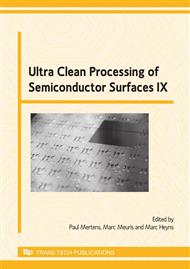p.177
p.181
p.185
p.189
p.193
p.197
p.203
p.207
p.211
Effect of Wet Treatment on Stability of Spin-On Dielectrics for STI Gap-Filling in Nanoscale Memory
Abstract:
As a design rule of memory devices is scaled down to sub-100 nm, shallow trench isolation (STI) technology is faced with gap-filling problem in case of CVD oxide and O3-TEOS oxide processes. To overcome the gap-filling problem, a perhydropolysilazane (PHPS) based spin-on dielectric (SOD) has been implemented for nanoscale devices because of self-planarization and excellent gap-filling property [1]. However, the stability of the SOD has been concerned about because it has relatively softer and more porous than conventional HDP oxide. In this paper, we report the effect of wet oxidant treatment on the stability of the SOD for STI gap-filling.
Info:
Periodical:
Pages:
193-196
Citation:
Online since:
January 2009
Keywords:
Price:
Сopyright:
© 2009 Trans Tech Publications Ltd. All Rights Reserved
Share:
Citation:


